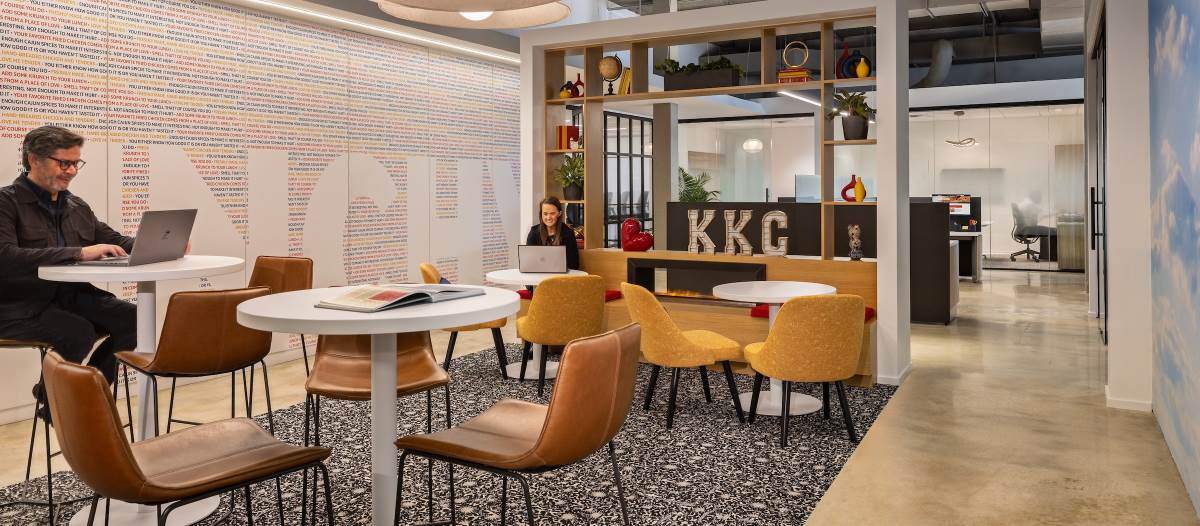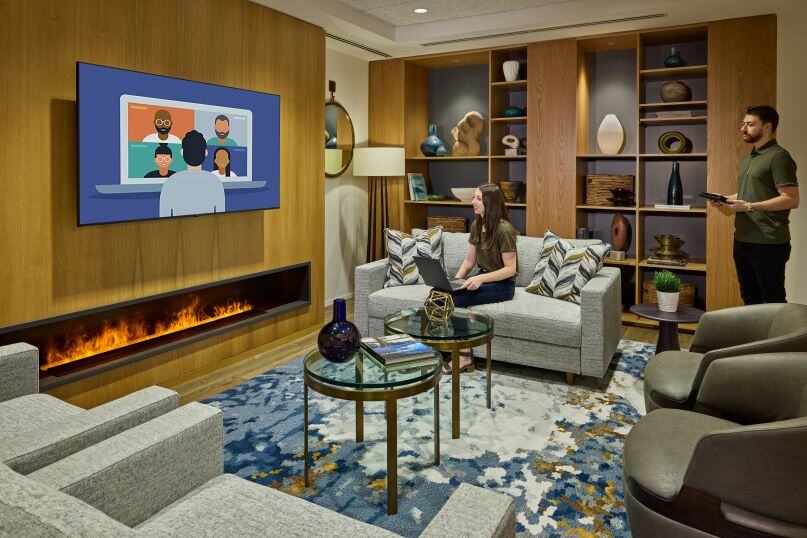Focus on Workplace Design
The hybrid workplace experience

Successful projects start with developing a solid workplace strategy layered with a human-centric design approach by gaining a deep understanding of an organization’s culture, values and goals. From the very start of a project, human-centricity defines how the client partners with the design professionals to develop an approach that allows them to understand better what is at stake. Human-centricity shows up in holistic questioning and addresses how to uncover and articulate the “why” that can drive decisions and build momentum. It can also inspire design professionals to go the extra mile to meaningfully engage a wide range of stakeholders in the project’s process, with the added benefit of minimizing risk and increasing the likelihood of successful change.

When bringing in an outside team, learning about the organization is the first key factor, and it requires acquiring knowledge not just from a quantitative standpoint but from the qualitative characteristics that make up the company. Meeting with senior leaders to set goals for success is imperative. This effort creates an overall roadmap for the project and an initial understanding of the organization’ s readiness for change. It can also help define where the investment should be made in workplace solutions.
To further the awareness of an organization and the workplace experience, learning a “day in the life” of its employees is a crucial step to understanding how the space can successfully support the organization and its people. Effective engagement with stakeholders and employees is critical to shaping successful workplace transformations. By soliciting feedback, organizations can comprehensively understand employee preferences and work dynamics, informing design decisions that prioritize collaboration, innovation and well-being. This data can be gleaned through focus groups, surveys, and one-on-one interviews. It can also help identify any change initiatives that may be needed.
Moreover, implementing a robust change engagement strategy ensures that employees have the knowledge and support needed to adapt to new work paradigms, facilitating smoother transitions and increased buy-in. The more involved the employee is in the process, the more likely they are to respond positively to changes in the workplace. By aligning design strategies with the business objectives, culture, mission, vision, values and branding, designers can create environments that resonate with employees, fostering an improved sense of belonging and purpose.
Flexible & adaptable spaces
As the hybrid work model establishes itself as a lasting practice, employers address employee needs to help with retention and growth. Flexibility is more than where employees work; it is about how they can complete their work. Organizations are reimagining traditional office spaces to accommodate a blend of in-person and remote work. Flexible workplace neighborhoods, organized around work styles rather than job titles, promote collaboration and adaptability, catering to the diverse needs of hybrid teams. Providing a choice of seating options and more accessible technology offers flexibility for employees, supports alignment with the specific activities within their day, and encourages interaction between employees to help facilitate collaboration. It provides a sense of belonging paramount in employees’ decision to return to the office.
Sense of wellness & connection
More than ever, employees are looking for connection, mentorship and a feeling of teamwork. This is a main driver for employees’ preference to be in the office rather than working from home. Employees can find an enhanced sense of belonging by incorporating amenities and collaborative work areas that provide natural connections and interactions throughout the day. High-performing teams thrive within a culture of communication, collaboration, continuous learning and trust. The workplace can support these outcomes.
In addition, employers are increasing their focus on supporting the health and wellness of their employees through the enhanced services they provide and incorporating spaces that promote the health and wellness of the individual. Workplace solutions designed with universal design principles, ergonomic solutions and elements of biophilic design that support overall wellness have proven to improve employee satisfaction and performance.
In creating meaningful hybrid workplace experiences, companies are not only focusing on the “me” space for improved support and comfort of the individual but also considering how the “we” space can support as well, layered with technology that enables environments to extend beyond the workplace to the building and neighborhood amenities.
Use of technology
Strategic integration of technology infrastructure in the workplace is continuing to be an essential investment. Technology that allows for collaboration in person and virtually enhances the hybrid workplace experience, empowering employees to transition seamlessly between physical and virtual environments. Leveraging technology-enabled solutions, such as sensors and digital workplace platforms, helps gather data-driven insights and optimize space utilization, ensuring that work environments remain agile and responsive to evolving needs. This includes integrating intelligent building technologies through building automation systems that are monitored for usage and can be adjusted to support the comfort of the occupants and save on energy consumption.
Building amenities
From the moment employees leave for their commute to the office, they consider how the workplace may support their day, ranging from the conveniences of services along the commute route to the amenities near and within the building. Many organizations are evaluating how robust amenities in the building and workspaces can enhance the employee experience and entice them to be in the office more frequently.
For a successful workplace experience, the evaluation does not stop once the space is built and individuals are moved in. Testing and monitoring the new space is essential, especially within the first year. This post-occupancy step can support subtle adjustments as employees adapt to the new work environment. Questions to ask include:
- Are spaces being utilized as intended?
- What spaces are used more frequently and why?
- Does technology support the intended goal, and does the employee understand how to use it?
Using post-occupancy evaluations in the workplace supports individuals’ ability to embrace new working methods. It fosters a culture of adaptation, allowing companies to remain agile and resilient in the face of change and positioning them for long-term success in an increasingly dynamic business landscape.
As organizations embrace the opportunities and challenges of hybrid work models, workplace design becomes more pivotal in shaping employee experiences and driving organizational success. By prioritizing engagement, flexibility and well-being, companies can create environments that empower employees to thrive in an ever-evolving work landscape. With strategic design solutions and a commitment to innovation, organizations can unlock the full potential of the hybrid workspace experience, fostering collaboration, creativity and resilience in the modern workplace.
Employees can find an enhanced sense of belonging by incorporating amenities and collaborative work areas.
Leveraging technology-enabled solutions, such as sensors and digital workplace platforms, helps gather data-driven insights and optimize space utilization.

Jennifer Treter, managing principal at Hendrick, has held a senior leadership position for more than 20 years and is the driving force behind all operational initiatives. She earned her Bachelor of Interior Design from Auburn University and is affiliated with the National Council for Interior Design Qualification, CoreNet Global and Metro Atlanta Chamber and is a LEED Accredited Professional.
Read more on Technology , Occupancy & Human Factors and Workplace
Explore All FMJ Topics









